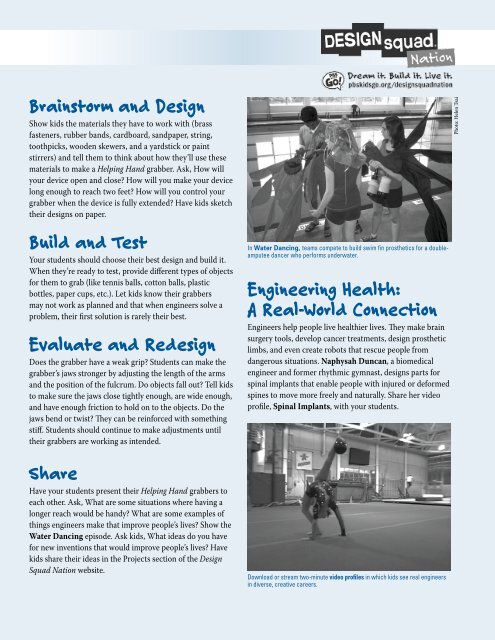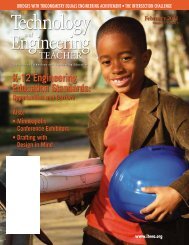March - Vol 70, No 6 - International Technology and Engineering ...
March - Vol 70, No 6 - International Technology and Engineering ...
March - Vol 70, No 6 - International Technology and Engineering ...
You also want an ePaper? Increase the reach of your titles
YUMPU automatically turns print PDFs into web optimized ePapers that Google loves.
Brainstorm <strong>and</strong> Design<br />
Show kids the materials they have to work with (brass<br />
fasteners, rubber b<strong>and</strong>s, cardboard, s<strong>and</strong>paper, string,<br />
toothpicks, wooden skewers, <strong>and</strong> a yardstick or paint<br />
stirrers) <strong>and</strong> tell them to think about how they’ll use these<br />
materials to make a Helping H<strong>and</strong> grabber. Ask, How will<br />
your device open <strong>and</strong> close? How will you make your device<br />
long enough to reach two feet? How will you control your<br />
grabber when the device is fully extended? Have kids sketch<br />
their designs on paper.<br />
Build <strong>and</strong> Test<br />
Your students should choose their best design <strong>and</strong> build it.<br />
When they’re ready to test, provide different types of objects<br />
for them to grab (like tennis balls, cotton balls, plastic<br />
bottles, paper cups, etc.). Let kids know their grabbers<br />
may not work as planned <strong>and</strong> that when engineers solve a<br />
problem, their first solution is rarely their best.<br />
Evaluate <strong>and</strong> Redesign<br />
Does the grabber have a weak grip? Students can make the<br />
grabber’s jaws stronger by adjusting the length of the arms<br />
<strong>and</strong> the position of the fulcrum. Do objects fall out? Tell kids<br />
to make sure the jaws close tightly enough, are wide enough,<br />
<strong>and</strong> have enough friction to hold on to the objects. Do the<br />
jaws bend or twist? They can be reinforced with something<br />
stiff. Students should continue to make adjustments until<br />
their grabbers are working as intended.<br />
Share<br />
Have your students present their Helping H<strong>and</strong> grabbers to<br />
each other. Ask, What are some situations where having a<br />
longer reach would be h<strong>and</strong>y? What are some examples of<br />
things engineers make that improve people’s lives? Show the<br />
Water Dancing episode. Ask kids, What ideas do you have<br />
for new inventions that would improve people’s lives? Have<br />
kids share their ideas in the Projects section of the Design<br />
Squad Nation website.<br />
In Water Dancing, teams compete to build swim fin prosthetics for a doubleamputee<br />
dancer who performs underwater.<br />
<strong>Engineering</strong> Health:<br />
A Real-World Connection<br />
Engineers help people live healthier lives. They make brain<br />
surgery tools, develop cancer treatments, design prosthetic<br />
limbs, <strong>and</strong> even create robots that rescue people from<br />
dangerous situations. Naphysah Duncan, a biomedical<br />
engineer <strong>and</strong> former rhythmic gymnast, designs parts for<br />
spinal implants that enable people with injured or deformed<br />
spines to move more freely <strong>and</strong> naturally. Share her video<br />
profile, Spinal Implants, with your students.<br />
Download or stream two-minute video profiles in which kids see real engineers<br />
in diverse, creative careers.<br />
Photo: Helen Tsai<br />
22 • <strong>Technology</strong> <strong>and</strong> <strong>Engineering</strong> Teacher • <strong>March</strong> 2011
















